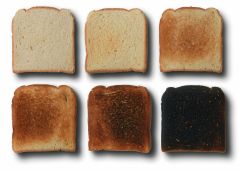Carbohydrates: dextrinization

As well as changing the colour of the food, dextrinization can also change the taste, aroma, or even the flavour. A typical example is toast.
How does it happen?
You may have noticed if you cook baked food in the oven, such as a cake, or bread, the outside of the food goes a darker colour. During the heating process, the starches within the food are broken down (by a chemical reaction) into sugars called dextrin. Dextrins are brown in colour and have a distinct taste and consistency. Producing dextrin therefore results in a change in colour of food to golden brown. This is the process called dextrinization.
Over heating
What happens if the food is cooked for too long? If toast is overcooked it goes black and burnt. Overcooking causes the starch to turn to carbon.
Recap: some of the dextrins produced are pyrodextrins. Pyrodextrins can give the bread crusts and toast a “toasted” flavour.


